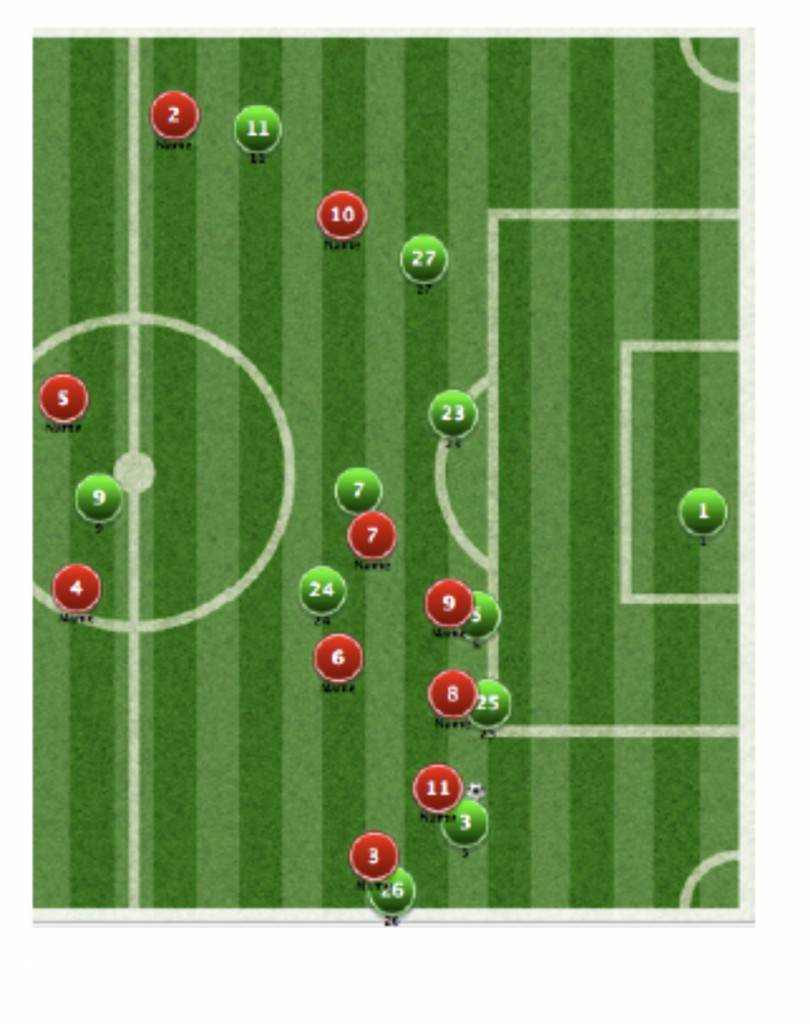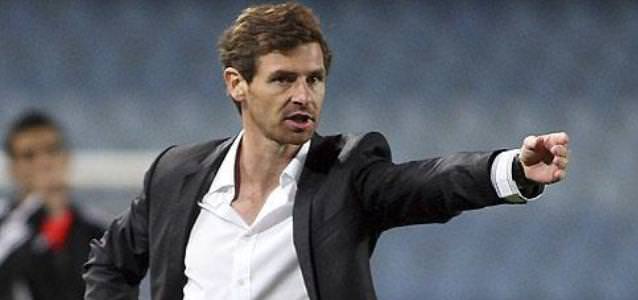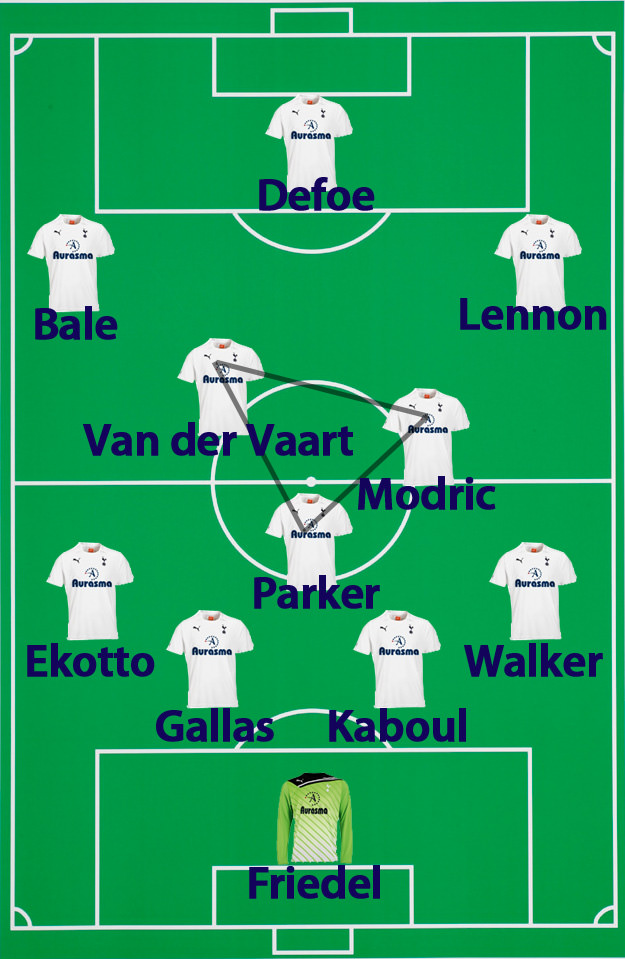With the high probability of Andre Villas Boas becoming the new Tottenham Hotspur manager in the near future, so much so that mybet bonus code were not giving punters much in the way of a return. TPiMBW has taken an objective step back from his recent Chelsea venture to analyse just how Andre Villas Boas proposes that his teams play their football. English Premier League fans may be aware that he possesses facial hair styled to perfection and presents himself as the immaculate gentleman, but his time at Chelsea didn’t present him with the opportunity to get his concepts across – Tottenham however, is a whole different proposition.
What to expect: André Villas Boas is a manager to believes that the strength of his team is focused around a particular system and as we saw at Chelsea, is a manager who is consistent with his proposed style of play, even through poor spells. But don’t write him off just yet, to judge him on his Chelsea performance would be unwise.
With the ball: AVB prefers his team to be patient in possession and ‘pick the lock’ at the right moment. One of the key factors for his failure at Chelsea has often been suggested that AVB was lacking a creative midfielder, one just like Modric. A breed of creativity and flair that was also present in his Porto side through the talent of Joao Moutinho. André Castro was Joao Mouthinho’s understudy at Porto and under the supervision of Villas Boas appears to have become a play-making clone of Mouthinho.
Villas Boas has also demonstrated at both clubs he likes to play a formation with two dynamic, fast and goal scoring inside forwards/wingers. Sturridge and Mata were instructed to take up these roles at Chelsea and both did a reasonable job at adapting to AVB’s ideologies, however neither are naturally players positioned on the flanks. At Porto AVB boasted the skills and pace of Varela and Hulk, two players that Lennon and Bale are more than a match for, two game changers.
The basis of AVB’s strategy is that when his side are in possession, the pitch is made as big as possible by spreading the formation out wide and utilising the space created by getting the wide men on the ball as often as the centralised play-makers.
AVB is clearly a firm believer in the old footballing proverb that ‘possession is nine-tenths of the game.’ The logic behind this belief is twofold. If you have the ball, the other team cannot score and secondly, if your team have the ball the opposition become exhausted chasing you down. This therefore has two desired effects, one is that the opposition are so tired than upon winning the ball from you, they are easier to press and tackle in the following moments of play; secondly, their attacks become slower and a lot more predictable: either through a resort to long ball or the struggle to retain possession and get a foothold in the game. ‘Keep ball’ has the potential to act as a virtuous cycle.
Without the ball: AVB presses high up the field and is unlikely to sit back against anyone, not even Man City or United. One particular issue at Chelsea was that of a slow back line and it would be fair to say they failed to cope with defending any immediate counter attack.
AVB conducts his team in this way so that the pitch is made as small as possible for opponents: by squeezing up the back line and using the off side trap aggressively – the opposite to when in possession. This tactic requires quick defenders to successfully cope with any threat of the long ball over the top.
Pressing in the right areas and at the right times can lead to a significant source for lots of goals:
“A study in 1988 of 16 international matches showed that possession was won 13% of the time in the attacking third. A staggering 66% of goals scored were from this 13%.” Paul Cooper
 The above image was taken from an excellent article about Brendan Rodgers’ pressing approach and shows just how effective high pressing can be – the left back in the above image is limited to route one or to play the ball back to his goal keeper, who is also likely to play a route one ball. Route one football more often than not results in the ball being turned over back to the defending side.
The above image was taken from an excellent article about Brendan Rodgers’ pressing approach and shows just how effective high pressing can be – the left back in the above image is limited to route one or to play the ball back to his goal keeper, who is also likely to play a route one ball. Route one football more often than not results in the ball being turned over back to the defending side.
While Rodgers and Boas represent different schools of football philosophy, their approach to pressing is similar. Rodgers relies on the concepts derived from Tiki Taka football, AVB however you could argue takes much of his concepts from Rinus Michels’ totaalvoetball of Ajax in the 1970’s, a type of football that Michels actually called himself ‘pressing football’:
“I would describe what the journalists call ‘total football’, as ‘pressing football’. To me, this expression seems to put the emphasis on the type of football I was trying to create with Ajax and with the Dutch national team in the 1974 World Cup. What I wanted to create was a game in which all ten outfield players pressed forward all the time – even when we didn’t have the ball!” Rinus Michels, ex Ajax Manager and creator of ‘totaal voetball’
Differences however, lie in the rigidity of structure in formation between total football and Villas-Boas’ approach. Many would argue here that Tiki-Taka is simply a rebrand of Total Football, however there are many differences between the two that have come around as a response to player strengths within a team.
AVB likes players who can defend from the front and attack from the back. Full backs with attacking qualities would prosper in AVB’s tactical approach.
While the formation above shows both Modric and Van der Vaart both within the midfield axis, it is likely that Sandro will have a larger role to play. However, during AVB’s Porto days he played both Mourinho and Fredy Guarin in the same midfield – possibly suggesting that given he expects his team to be in possession more often than not, two ball playing midfielders would be acceptable.
Lastly, Jermaine Defoe may well be offered a lifeline and find a regular spot in AVB’s tactical approach. Radamel Falcao was a player who simply scored goals. Of course, there is nothing simple about scoring goals and the player who is selected to play up front is expected to be in the right place at the right time – all the time:
“The big thing is everybody says it’s being in the right place at the right time. But it’s more than that, its being in the right place all the time. Because if I make 20 runs to the near post and each time I lose my defender, and 19 times the ball goes over my head or behind me – then one time I’m three yards out, the ball comes to the right place and I tap it in – then people say, right place, right time. And I was there ALL the time” Gary Lineker
While the same players are all listed in the formation above as the familiar faces we saw under Redknapp, the most fundamental changes come from the pressing and build up play differences of the two styles of football.
Conclusion
AVB’s tactical foundations are based around a fluid passing game but in a strict and rigid formation. He has a track record in showing a belief that players should be selected that fit his system and not a system chosen to cater for the best players.
The possible appointment of AVB would represent a move away from Redknapp and his adaptive tactics to fit the best players in a side to Villa Boas’ approach to fit players to a system, a selection of the best team, not players.
Clearly, the key for AVB succeeding at Spurs comes down to whether he is able to keep players: Luka Modric and Gareth Bale in particular. Both are players who fall perfectly into place with his tactical set up and as Chelsea saw, it is not easy to implement AVB’s ideas without the correct typology of player in each given role.
The philosophy that AVB will propose aims to provide “freedom by design”, freedom of creative football by an implementation of structure.
The potential sales of both Bale and Modric however, would not be all doom and gloom as both would demand such large fees, which would therefore allow Villas Boas to actually go out and purchase players who fit his system – an opportunity he was never truly given at Chelsea. Don’t be too surprised to finally see AVB recruit some of his old Porto friends this time around.
It is worth reminding yourself however, that Tottenham have a youth player more than capable of stepping up to the big stage next season, a player who fits the creative midfield role like no other english player and impressed from start to finish in the NextGen Series last season: Alex Pritchard.
And Villas Boas is not one to be afraid to choose a youth player and allow him the opportunity, after all AVB’s career has been built around opportunities offered to him despite his age, and let us not forget… he is still only 34 years old himself!
“great moments…are born from great opportunity” Herb Brooks from the movie ‘Miracle’ 2004


